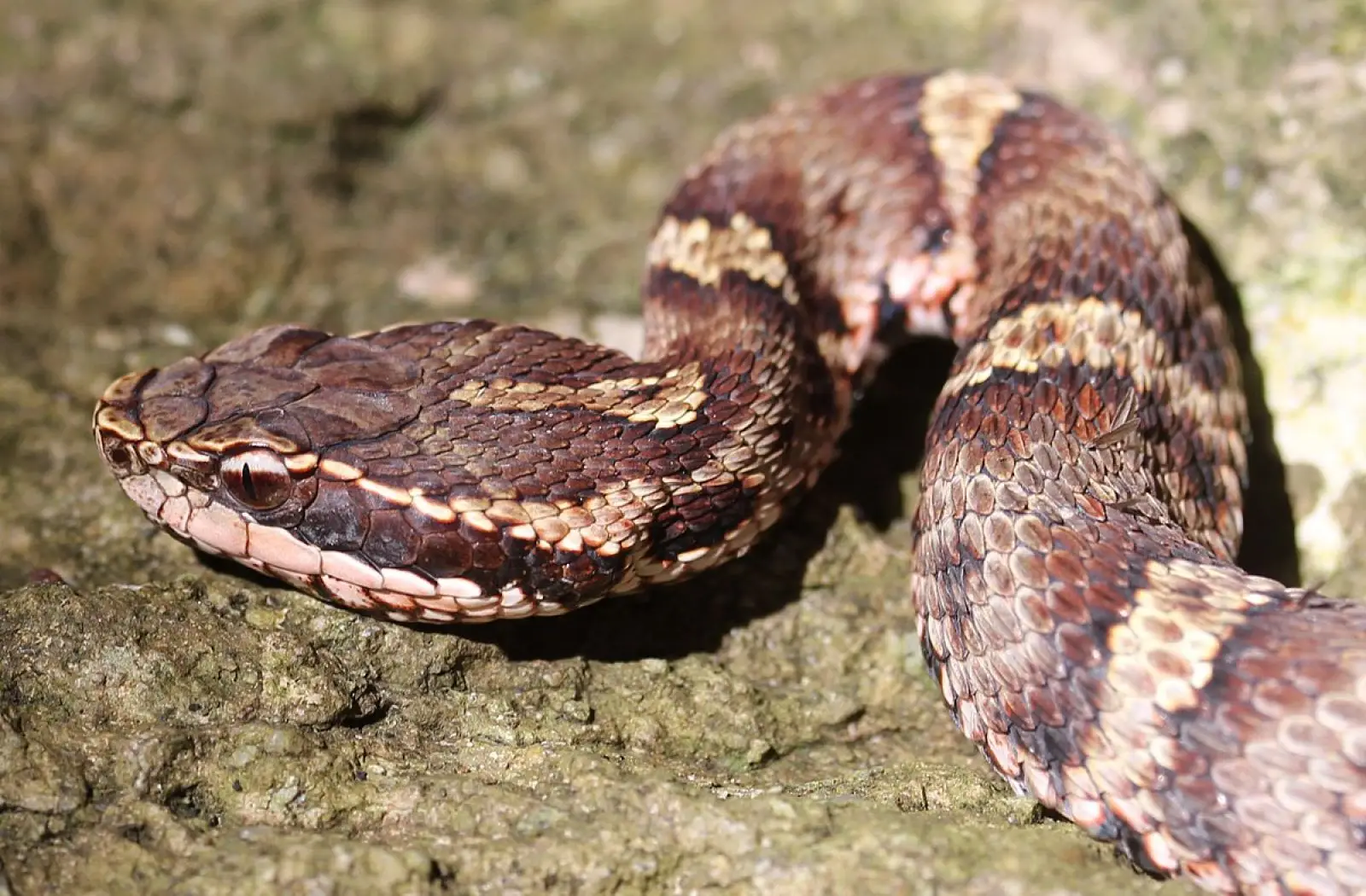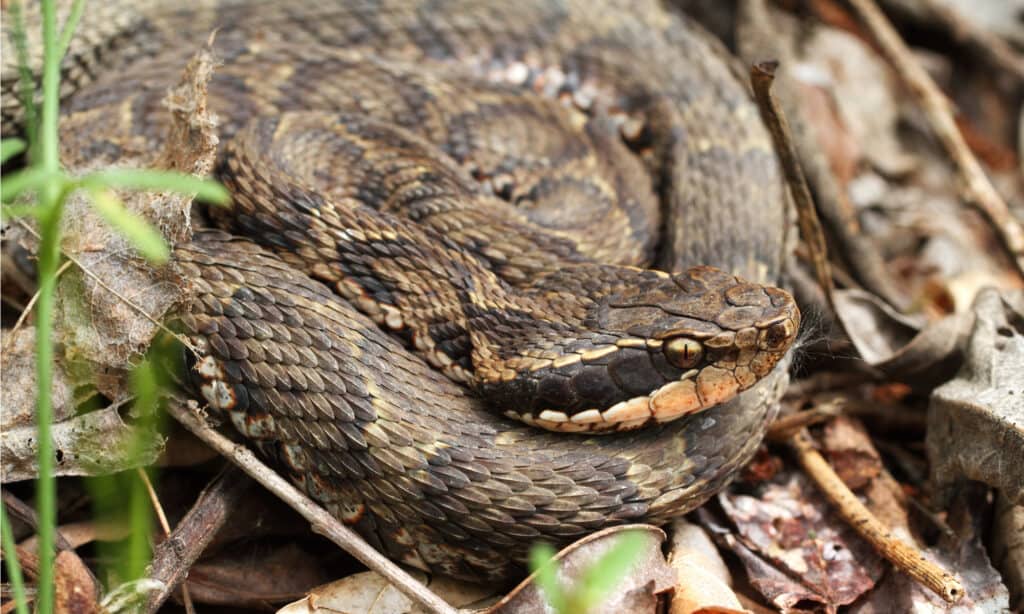The term Mamushi means more than just a song title. This small, venomous pit viper (Agkistrodon blomhoffi) lives across Japanese islands. The snake’s distinctive dark brown blotches on a pale gray background make it dangerous and fascinating, and it has become part of global pop culture.
Megan Thee Stallion’s release of “Mamushi,” with Japanese rapper Yuki Chiba, fits the snake theme that runs through her recent music. Their first cooperative effort came from Megan’s connections with talented local artists during her Japan tour. The song weaves snake imagery from Megan’s other tracks with Japanese cultural elements.
The lyrics “I get money, I’m a star” and their Japanese version show how confidence and success speak the same language in music. On top of that, Chiba’s (formerly known as KOHH) international fame grew after his versatile rap performance in Keith Ape’s “It G Ma” in 2015. This blend of East and West music styles engages listeners who want to learn about both mamushi’s literal meaning and the deeper symbolism in this unique collaboration.

Table of Contents
- 1 The Rise of ‘Mamushi’: From Album Track to Viral Hit
- 2 Meet the Artists: Megan Thee Stallion and Yuki Chiba
- 3 What Does ‘Mamushi’ Mean in Japanese?
- 4 Snake Symbolism in Megan’s Music
- 5 Breaking Down the Lyrics of ‘Mamushi’
- 6 Summing all up
- 7 Here are some FAQs about the Mamushi meaning:
- 7.1 What is mamushi in Korean?
- 7.2 What is mamushi snake in English?
- 7.3 Does mamushi mean snake?
- 7.4 Who are the Japanese girls in mamushi?
- 7.5 What is red devil in korean?
- 7.6 What is the myth of the mamushi?
- 7.7 What is the meaning of the Japanese word komorebi?
- 7.8 What do Japanese people call snakes?
- 7.9 Who is mamushi in Blue Exorcist?
The Rise of ‘Mamushi’: From Album Track to Viral Hit
Megan Thee Stallion’s “Mamushi” started as track number 10 on her third studio album but turned into a worldwide sensation. The song appeared on her self-titled album released June 28, 2024 and emerged as the standout track from the 18-song collection.
How the song gained popularity on TikTok
A viral dance trend on TikTok catapulted “Mamushi” to stardom. User @mona712_official created simple yet catchy choreography that sparked countless recreations. The song featured in 157,000 videos by July 9, 2024, and this number shot up to about 300,000 videos worldwide soon after. Content creators couldn’t resist the song’s chorus with its Japanese phrase “Watashi wa sutā” (meaning “I’m a star”).
TikTok Domination: The track reached No. 6 on the TikTok Viral 50 chart, showing its broad appeal. The dance moves were simple yet bold, making them easy for users of any skill level to learn. This helped the mamushi meaning spread naturally across social media.
The role of Megan Thee Stallion’s fanbase
Megan jumped on the trend herself. Her dance videos got 6.4 million likes and 43.4 million views. She even dressed up as Sailor Moon’s Usagi Tsukino in one video, showcasing her love for anime and Japanese culture.
Her devoted fans, known as “Hotties,” helped spread the mamushi song meaning everywhere. Many fans loved the bilingual aspect of the track and tried learning the Japanese lyrics.
The song reached new heights when Megan performed it at Kamala Harris’ first campaign rally in Atlanta. This performance brought the track to audiences beyond her usual fanbase.
Initial reactions to the Japanese lyrics
People wanted to understand what they were singing, making the mamushi lyrics translation a hot topic. The chorus has two parts: Yuki Chiba sings “Okane kasegu, orera wa sutā” (お金稼ぐ 俺らはスター), meaning “We make money, we are stars.” Megan follows with “Watashi wa sutā” (私はスター), which means “I’m a star”.
The Japanese pronouns used caught fans’ attention. Chiba uses “ore,” an informal masculine self-reference, while Megan chose “watashi,” a more formal or feminine self-reference. This clever detail added layers to the mamushi lyrics meaning and showed respect for cultural nuances.
Japanese audiences appreciated how the song honored their language and culture. A Japanese commentator pointed out, “These days a lot of Korean pop stars collaborate with Western musicians but not so much Japanese artists at all”. This East-West musical blend stood out.
The song’s viral success led to its release as a single on urban radio July 30. It became the most-added song on the format. This move helped “Mamushi” evolve from an album track to a genuine hit, bringing the megan thee stallion mamushi meaning to mainstream audiences.
Meet the Artists: Megan Thee Stallion and Yuki Chiba
Two amazing artists came together to create the viral hit “Mamushi”. Their unexpected musical fusion turned into something bigger than entertainment. This partnership became one of the most important moments in cross-cultural music exchange.
Who is Yuki Chiba (formerly KOHH)?
Yuki Chiba was born on April 22, 1990, in Oji, Kita Ward, Tokyo. He first made his mark under the stage name KOHH. His music career started when he turned 18. He produced and recorded mixtapes until he met producer 318 and released music under GUNSMITH PRODUCTION.
His life story adds layers to his art. He grew up with a single Japanese mother in tough conditions that shaped his raw, powerful lyrics. His Korean father died by suicide while under the influence of drugs. His mother struggled with methamphetamine addiction. These hardships helped Chiba create a unique sound that struck a chord with his audience.
The album MONOCHROME became his breakthrough in 2014, leading urban acts to success. He worked with Keith Ape the next year on “It G Ma”. The track became huge in Japan and South Korea and caught international attention. This success marked his first big step into the global music scene.
Chiba took a three-year break and dropped the KOHH name in 2021. He now performs using his birth name. His music video “Team Tomodachi” went viral in February 2024, marking his powerful comeback.
Megan’s trip to Japan and the collaboration origin
Megan Thee Stallion’s love for Japan grew in March 2024 during her Tokyo visit for the Crunchyroll Anime Awards[102]. She presented the Anime of the Year award to Jujutsu Kaisen on March 2. She showed her true anime fan spirit by wearing a custom outfit inspired by Bruno Bucciarati from JoJo’s Bizarre Adventure: Golden Wind.
Megan dove deep into Japanese culture during her stay and shared her adventures on social media. She met several talented local artists, including Yuki Chiba. They took a picture together, which Megan posted on March 5. This moment likely sparked their “Mamushi” collaboration.
Why this East-West fusion matters
Megan and Yuki’s partnership goes beyond creating a catchy song with the mamushi meaning at its heart. It brings together Western hip-hop’s power and Japanese artistic tradition’s rich history.
Yes, it is a standout partnership in today’s music world. A Japanese commentator said about the mamushi song meaning, “These days a lot of Korean pop stars collaborate with Western musicians but not so much Japanese artists at all” [previously cited]. This makes their cultural exchange special.
The mamushi lyrics meaning shows how music can connect across languages and borders. They mixed Megan’s Houston roots with Yuki’s Japanese heritage to create something that touched people worldwide. The song reached number 68 on the US Billboard Hot 100, giving Chiba his first entry on this prestigious chart.
Their performance at the 2024 MTV Video Music Awards sealed this cross-cultural partnership in music history. It proved that the mamushi meaning in japanese could reach global audiences and achieve commercial success.
What Does ‘Mamushi’ Mean in Japanese?
The viral song “Mamushi” has a darker side to its catchy beats. Most fans dancing to this track don’t know they’re grooving to a song named after Japan’s deadliest native snake.
Literal translation and pronunciation
The mamushi meaning in Japanese points to a pit viper species that calls Japan home. The word “mamushi” (蝮) simply means “pit viper” in Japanese, and its kanji character represents this dangerous reptile. Non-Japanese speakers can say it as “mah-moo-she” with each syllable getting equal stress.
The mamushi meaning song fits right into Megan Thee Stallion’s snake imagery theme. The “Mamushi” music video shows Megan as a femme fatale who changes into this deadly serpent. She lures male gangsters to a Japanese bathhouse and ends up killing them. This visual story shows how the mamushi lyrics meaning goes beyond just words to capture the snake’s deadly nature.
Biological background: the mamushi snake
Scientists know this snake as Gloydius blomhoffii, and it stands as one of Japan’s most dangerous creatures. The japanese mamushi ranks with the yamakagashi and Okinawan habu as the three most venomous snakes in Japan’s islands.
The numbers tell a scary story – each year, this snake bites 2,000-3,000 people in Japan. The good news? All but one of these bites rarely turn deadly, with just 5-10 deaths from thousands of cases. Victims spend about a week in the hospital, and the worst cases need intensive care.
Like other pit vipers, the mamushi snake has some key features:
- Long hollow fangs that automatically deploy when the mouth opens
- Large poison glands that give the head a triangular shape
- A habitat range including meadows, woodland, swamps, mountains, and rocky outcroppings
Cultural associations with snakes in Japan
The mamushi meaning japanese culture runs deeper than its scary reputation. Japanese folk medicine has used this snake to heal for centuries. People eat boiled mamushi to boost blood levels or put its raw flesh on wounds.
The sort of thing I love is how they make “Mamushi Zake” by preserving the snake in alcohol. People believe this drink boosts male virility, based on the snake’s impressive mating sessions that can last up to 26 hours. Recent studies hint that these snake wines might actually help with pain and inflammation.
The mamushi also held a special place in spiritual beliefs as a kami (god). People once thought killing these snakes would bring bad luck, though this belief has faded with time.
The megan thee stallion mamushi meaning smartly builds on this cultural history. She comes across as powerful and potentially dangerous – just like the snake itself. This symbolism adds depth to the mamushi lyrics translation by blending old Japanese culture with modern hip-hop.
Snake Symbolism in Megan’s Music
Snakes have slithered through Megan Thee Stallion’s recent musical catalog. This recurring motif concludes with the mamushi meaning in her latest hit. The reptilian symbolism goes beyond attention-grabbing imagery and tells a story of personal transformation and artistic rebirth.
Recurring snake themes in ‘Cobra’ and ‘Hiss’
Megan’s snake trilogy started with “Cobra” in October 2023. She rapped about shedding her past and embracing newfound independence. Her venomous imagery continued in January 2024 with “Hiss,” where her lyrics warned detractors about her bite.
These tracks made serpents into symbols of Megan’s power and warning signals to her adversaries. The mamushi snake symbolism builds on this foundation and adds Japanese cultural elements that expand her artistic reach.
How ‘Mamushi’ fits into Megan’s transformation arc
The mamushi meaning song marks the peak of Megan’s snake-themed progress. “Cobra” tackled her personal struggles and “Hiss” faced enemies head-on. The mamushi lyrics meaning now shows Megan at her most confident as she collaborates across cultures.
The music video shows Megan as a deadly serpent in human form who lures unsuspecting men to their doom. This visual storytelling mirrors the actual japanese mamushi’s deadly reputation, creating a perfect match between the song’s title and its message of danger-driven power.
Symbolism of shedding skin and rebirth
The snake trilogy uses snakes’ biological skin-shedding as a metaphor for personal renewal. Snakes must shed their old skin to grow in nature. This process mirrors Megan’s artistic growth and career transformation.
The megan thee stallion mamushi meaning becomes relevant with the artist’s recent professional changes, including her break from previous label commitments. Like her serpentine alter ego, Megan has emerged from her old skin more powerful and dangerous to those who doubt her.
These three songs, ending with mamushi lyrics translation, tell a compelling story of change. Megan transforms from vulnerable to strong, from victim to victor, and from local talent to global star.

Breaking Down the Lyrics of ‘Mamushi’
The lyrics of “Mamushi” offer fascinating layers of meaning that blend two languages. This bold statement about success and stardom has found worldwide appeal.
Chorus meaning and gendered language in Japanese
The catchy chorus switches between Yuki Chiba’s “お金稼ぐ 俺らはスター” (Okane kasegu, orera wa sutā) which means “We make money, we are stars” and Megan’s “お金稼ぐ 私はスター” (Okane kasegu, watashi wa sutā) meaning “I earn money, I’m a star”. The language choices make this even more compelling. Chiba uses “ore,” a casual masculine self-reference, while Megan chooses “watashi,” a more refined feminine way to address oneself in Japanese.
Verse highlights: Megan’s and Yuki’s viewpoints
Megan radiates confidence in her verse with lines like “He know who I am, ain’t had to say my name” and “I think I’m so sexy, every shirt I own is cropped”. She shows off her money-making abilities by comparing them to Tetris.
Yuki takes a more thoughtful look at stardom. He asks “流れる星たち どこに向かう?” (Flowing stars, where are they headed?). His lyrics paint pictures of “shiny diamonds” and late-night studio sessions.
Mamushi lyrics translation and interpretation
The mamushi lyrics meaning goes deeper than simple translation. These lyrics are a “bold and unapologetic celebration of self-made success”. The repeated word “キラキラ” (kirakira), meaning “glittering,” reinforces their star status.
How the lyrics reflect fame and identity
Both artists proudly own their achievements. Megan’s Japanese line “私、可愛い いい体” (Watashi, kawaii ii karada – “I’m cute, I have a nice body”) shows her confidence crosses language barriers.
Why ‘Watashi wa suta’ became a TikTok trend
“Watashi wa sutā” caught fire on TikTok. Users worldwide connected with this simple yet powerful declaration of stardom. Megan joined the trend herself and even dressed up as Sailor Moon’s Usagi Tsukino in one video.
Summing all up
“Mamushi” definitely marks an amazing cultural moment that turned a Japanese venomous snake name into worldwide music magic. This final song in Megan Thee Stallion’s snake-themed trilogy hits different. The collaboration with Yuki Chiba brings Japanese culture straight to Western listeners in the most natural way.
Music’s power to surpass language barriers shines through in “Mamushi’s” success. Track number 10 from Megan’s album turned into a viral hit thanks to a simple yet addictive TikTok dance. Fans worldwide connected with the catchy “Watashi wa sutā” phrase, whatever their Japanese knowledge. The song shows how art brings people together from different backgrounds.
Japanese artists rarely team up with Western musicians, which makes this partnership special. Yuki Chiba’s story from tough times to global recognition adds real depth to the song. Megan’s genuine love for Japanese culture makes their teamwork feel real and respectful.
The mamushi snake adds layers of meaning to the track. Japanese people see this venomous pit viper as both deadly and healing – just like Megan portrays herself as dangerous to enemies while healing through her art. This cultural mix works beautifully on every level – from words to music to symbols.
“Mamushi” ended up becoming more than just another bilingual banger. The song shows artists can borrow from other cultures with respect and create something fresh. This track’s rise from album cut to global hit proves modern music knows no borders. A dangerous Japanese snake became the unlikely star of this year’s most exciting musical moments.
Here are some FAQs about the Mamushi meaning:
What is mamushi in Korean?
In Korean, “mamushi” (마무시) is not a standard word and appears to be a borrowing from Japanese. The song title and its associated mamushi meaning song phenomenon have generated interest in the term across languages. The primary cultural reference remains rooted in Japanese language and mythology.
What is mamushi snake in English?
In English, the mamushi snake is known as the Japanese pit viper or Japanese moccasin. This venomous snake is native to Japan and other parts of East Asia. The creature’s dangerous nature contributes to the metaphorical mamushi lyrics meaning in various musical contexts.
Does mamushi mean snake?
Yes, mamushi does mean snake, specifically referring to the Japanese pit viper (Gloydius blomhoffii). However, in contemporary usage, particularly in music, it has taken on additional symbolic meanings. The exploration of megan thee stallion mamushi meaning examines how the term extends beyond its literal translation.
Who are the Japanese girls in mamushi?
The “Japanese girls” referenced in the mamushi context likely appear in music videos or lyrical content related to songs using this term. Their specific identities would depend on the particular artistic production being referenced. This visual element contributes to the overall mamushi song meaning in its cultural presentation.
What is red devil in korean?
In Korean, “red devil” is typically translated as “붉은 악마” (bulgeun angma). This term is unrelated to the mamushi concept, though both may appear in different cultural or musical contexts. The Mamushi Meaning remains distinct within Japanese language and symbolism.
What is the myth of the mamushi?
In Japanese folklore, the mamushi snake is often associated with transformation, danger, and sometimes even supernatural powers. These mythological associations have influenced how the term is used metaphorically in modern contexts, including music. Understanding this background is crucial to interpreting the full mamushi lyrics meaning in contemporary songs.
What is the meaning of the Japanese word komorebi?
Komorebi is a beautiful Japanese word describing sunlight filtering through trees. This term is unrelated to mamushi but demonstrates how Japanese words often carry specific natural imagery. Unlike komorebi’s peaceful connotations, Mamushi Meaning typically involves more dangerous or intense symbolism.
What do Japanese people call snakes?
Japanese people generally call snakes “hebi” (蛇), which is the standard word for serpent. “Mamushi” specifically refers to the Japanese pit viper species rather than snakes in general. This distinction is important for understanding the specific mamushi song meaning in cultural context.
Who is mamushi in Blue Exorcist?
In the anime/manga Blue Exorcist, Mamushi is a character who is a snake demon and member of the Impure King’s faction. This character embodies the dangerous and venomous qualities associated with the actual snake. The portrayal contributes to the broader cultural Mamushi Meaning in Japanese media.

